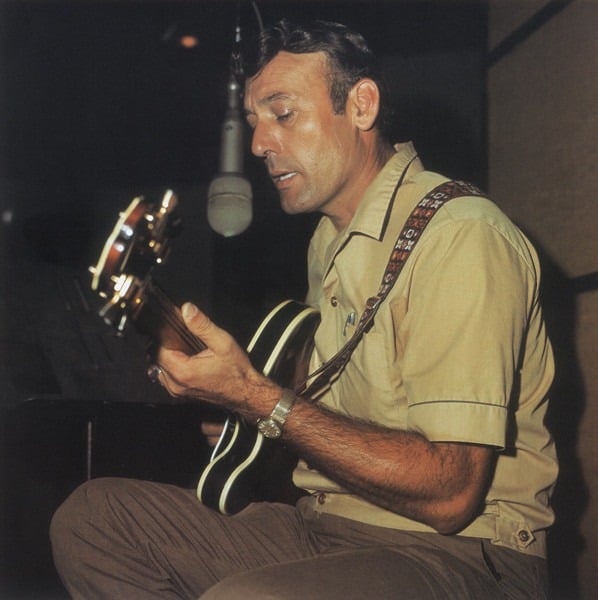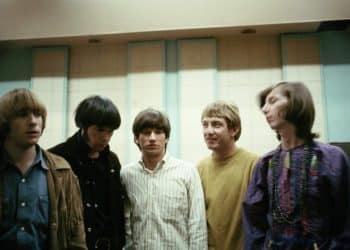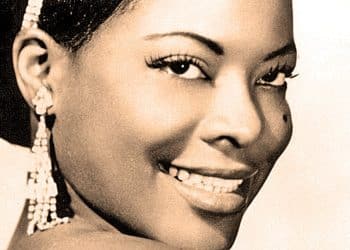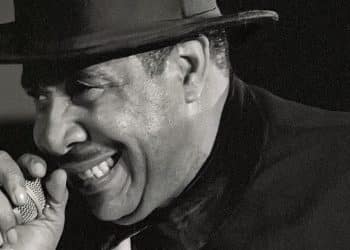Carl Perkins, often referred to as the “King of Rockabilly,” was a pioneering American musician and songwriter whose innovative blend of country, blues, and rockabilly helped shape the sound of early rock and roll. Born on April 9, 1932, in Tiptonville, Tennessee, Perkins began his musical career at a young age, learning to play guitar and honing his skills as a songwriter.
Perkins rose to fame in the 1950s with his hit song “Blue Suede Shoes,” which became an instant classic and one of the defining songs of the rock and roll era. His distinctive guitar licks, infectious rhythms, and soulful vocals set him apart from his peers and earned him a devoted following.
Throughout his career, Perkins continued to innovate and evolve, exploring new musical styles and collaborating with artists across genres. His influence extended far beyond his own recordings, with artists like Elvis Presley, The Beatles, and Johnny Cash citing him as a major inspiration.
Despite facing personal and professional challenges throughout his life, including a near-fatal car accident in 1956, Perkins remained dedicated to his music, leaving behind a rich legacy that continues to inspire musicians and fans alike. He was inducted into the Rock and Roll Hall of Fame in 1987 and remains revered as one of the pioneers of rock and roll.
1. Your True Love
“Your True Love” is a classic rock and roll song written by Carl Perkins, the iconic rockabilly artist known for his influential contributions to the early rock and roll era. Released in 1957 as the B-side to Perkins’ hit single “Matchbox,” “Your True Love” showcases Perkins’ signature blend of country, blues, and rockabilly styles.
With its catchy melody, energetic rhythm, and infectious guitar riffs, “Your True Love” exemplifies Perkins’ mastery of the rockabilly genre. The song features Perkins’ distinctive vocal delivery, characterized by his twangy voice and expressive phrasing, as well as his dynamic guitar playing, which blends elements of blues and country.
Lyrically, “Your True Love” explores themes of romance and longing, with Perkins singing about the joy of finding true love and the desire to be with that special someone. The song’s upbeat tempo and optimistic lyrics reflect the optimism and excitement of youth, making it a favorite among fans of early rock and roll.
Over the years, “Your True Love” has been covered by numerous artists and has become a classic of the rockabilly genre. Its infectious energy and timeless appeal continue to captivate listeners, solidifying Carl Perkins’ legacy as one of the pioneers of rock and roll.
2. Let the Jukebox Keep On Playing
“Let the Jukebox Keep On Playing” is a classic rock and roll song written and performed by Carl Perkins, the influential rockabilly artist known for his dynamic guitar playing and distinctive vocal style. Released in 1955 as the B-side to Perkins’ single “Gone, Gone, Gone,” “Let the Jukebox Keep On Playing” exemplifies Perkins’ talent for blending elements of country, blues, and rockabilly into a catchy and energetic tune.
The song features Perkins’ signature guitar licks, characterized by their driving rhythm and twangy tone, as well as his soulful vocals, which convey a sense of youthful exuberance and longing. With its infectious melody and upbeat tempo, “Let the Jukebox Keep On Playing” captures the spirit of the early rock and roll era, evoking images of jukeboxes, soda fountains, and carefree nights spent dancing and romancing.
Lyrically, “Let the Jukebox Keep On Playing” celebrates the joy of music and the power of rock and roll to bring people together. Perkins sings about the thrill of hearing his favorite songs on the jukebox and the happiness they bring, making the song a nostalgic ode to the heyday of rock and roll.
Over the years, “Let the Jukebox Keep On Playing” has become a favorite among fans of rockabilly music and a classic of the genre. Its infectious energy and timeless appeal continue to resonate with listeners, ensuring its enduring legacy as one of Carl Perkins’ most beloved songs.
3. Honey Don’t
“Honey Don’t” is a rockabilly song written by Carl Perkins, originally recorded in 1956. It gained prominence when The Beatles covered it for their 1964 album “Beatles for Sale.” The song features a lively tempo, catchy guitar riffs, and playful lyrics.
Lyrically, “Honey Don’t” humorously depicts the narrator’s frustration with his partner’s behavior. He expresses annoyance with her actions but ultimately declares his love and willingness to forgive her. The chorus, with its repetitive refrain of “Honey don’t,” adds to the song’s playful and light-hearted tone.
Musically, “Honey Don’t” is characterized by its upbeat rhythm and infectious energy. The song features Carl Perkins’ distinctive guitar style, which combines elements of rock and roll with country and blues influences. The driving rhythm section and lively tempo contribute to the song’s danceable groove.
The Beatles’ cover of “Honey Don’t” helped introduce the song to a new generation of listeners and solidified its place in rock music history. The band’s spirited rendition, featuring Ringo Starr on lead vocals, captured the song’s playful spirit and showcased their affinity for early rock and roll.
Overall, “Honey Don’t” is a fun and catchy rockabilly classic that continues to delight audiences with its infectious melody and lively rhythm.
4. That’s Right
“That’s Right” is a phrase commonly used in colloquial language to affirm a statement or acknowledge correctness. In music, “That’s Right” has also been used as a song title by various artists across different genres. However, without specific context regarding the artist or album, it’s challenging to provide a detailed description of a particular song titled “That’s Right.”
Songs titled “That’s Right” may vary significantly in style, theme, and musical elements depending on the artist and genre. Some songs with this title may feature upbeat rhythms, catchy melodies, and lyrics celebrating positivity or affirmation. Others may delve into deeper themes or emotions, exploring topics like love, self-expression, or personal empowerment.
Without additional information, it’s difficult to pinpoint a specific song titled “That’s Right.” If you have a particular song or artist in mind, providing more details would help in offering a more accurate description.
5. Movie Magg
“Movie Magg” is a charming and upbeat country song written and performed by Carl Perkins, a legendary figure in the rockabilly and early rock and roll genres. Released in 1955 as Perkins’ debut single, “Movie Magg” showcases his unique blend of country, blues, and rockabilly styles.
With its catchy melody, lively rhythm, and playful lyrics, “Movie Magg” captures the spirit of youthful romance and the excitement of going to the movies. The song features Perkins’ distinctive guitar playing, characterized by his energetic fingerpicking and nimble fretwork, as well as his warm and expressive vocals.
Lyrically, “Movie Magg” tells the story of a young couple’s trip to the cinema, where they enjoy watching a film together and sharing a moment of romance. Perkins sings about the thrill of being with his sweetheart and the joy of spending time together, making the song a nostalgic ode to teenage love and the simple pleasures of youth.
“Movie Magg” was a modest success upon its release, helping to establish Perkins as a rising star in the country music scene. Over the years, the song has become a favorite among fans of rockabilly and early rock and roll, celebrated for its infectious energy and timeless appeal.
6. Blue Suede Shoes
“Blue Suede Shoes” is a classic rock and roll song written and originally recorded by Carl Perkins in 1955. The song’s title refers to the iconic blue suede shoes, a symbol of style and fashion in the 1950s. “Blue Suede Shoes” is celebrated for its catchy melody, driving rhythm, and influential guitar riff.
Lyrically, “Blue Suede Shoes” tells the story of a man who warns others not to step on his blue suede shoes. The song’s narrator expresses pride in his footwear and issues a playful threat to anyone who might damage them. The chorus, with its memorable refrain of “You can do anything, but lay off of my blue suede shoes,” has become a classic rock and roll anthem.
Musically, “Blue Suede Shoes” is characterized by its upbeat tempo and energetic guitar work. The song features Carl Perkins’ distinctive guitar style, which blends elements of rockabilly, country, and blues. The driving rhythm section and infectious melody contribute to the song’s timeless appeal and enduring popularity.
“Blue Suede Shoes” quickly became a hit upon its release, reaching the top of the charts in both the United States and the United Kingdom. The song’s success helped establish Carl Perkins as a pioneering figure in the rock and roll genre and solidified his place in music history.
Over the years, “Blue Suede Shoes” has been covered by numerous artists and featured in various films, TV shows, and commercials. Its catchy melody and playful lyrics continue to captivate audiences and make it a beloved classic of the rock and roll era.
7. Matchbox
“Matchbox” is a classic rock and roll song written by Carl Perkins, one of the pioneering figures of the rockabilly genre. Originally released in 1956 as a single by Perkins, “Matchbox” became a hit, reaching the top ten on the Billboard charts and earning widespread acclaim for its catchy melody and energetic performance.
With its driving rhythm, infectious guitar riff, and spirited vocals, “Matchbox” exemplifies Perkins’ signature style of rockabilly, blending elements of country, blues, and rhythm and blues. The song features Perkins’ dynamic guitar playing, characterized by his lightning-fast fingerpicking and raw, twangy tone, as well as his distinctive vocal delivery, which is filled with charisma and attitude.
Lyrically, “Matchbox” tells the story of a man who’s down on his luck and trying to make ends meet. The narrator sings about his struggles with money and his desire to find a job, using colorful imagery and clever wordplay to express his frustration and resilience.
“Matchbox” has since become a rock and roll standard, covered by numerous artists across various genres, including The Beatles, who recorded a popular version of the song in 1964. With its timeless appeal and universal themes, “Matchbox” remains a beloved classic of the rockabilly genre, cementing Carl Perkins’ legacy as one of the founding fathers of rock and roll.
8. Everybody’s Trying To Be My Baby
“Everybody’s Trying to Be My Baby” is a rockabilly song written by Carl Perkins. It was first recorded by Perkins in 1957 and later popularized by The Beatles when they included a cover version on their 1964 album “Beatles for Sale.”
Lyrically, “Everybody’s Trying to Be My Baby” is a lighthearted and humorous song that tells the story of someone who is constantly being pursued by admirers. The narrator describes how everyone seems to be vying for their attention and affection, but they remain loyal to their true love. The song’s playful lyrics and catchy melody reflect the carefree spirit of rock and roll music from the 1950s and 1960s.
Musically, “Everybody’s Trying to Be My Baby” features a lively tempo, infectious guitar riffs, and a driving rhythm that is characteristic of the rockabilly genre. Perkins’ original recording showcases his distinctive guitar style, while The Beatles’ cover version adds their own unique flair, with George Harrison delivering a spirited vocal performance and contributing energetic guitar work.
The song’s catchy melody and memorable lyrics have made it a favorite among fans of rock and roll music. It has been covered by numerous artists over the years and remains a classic example of the genre. “Everybody’s Trying to Be My Baby” continues to be enjoyed by audiences of all ages for its timeless appeal and infectious energy.
9. Dixie Fried
“Dixie Fried” is a rollicking rock and roll song written by Carl Perkins, the influential rockabilly artist known for his dynamic guitar playing and distinctive vocal style. Released in 1956 as a single, “Dixie Fried” showcases Perkins’ unique blend of country, blues, and rockabilly styles.
With its infectious rhythm, driving beat, and lively guitar licks, “Dixie Fried” captures the spirit of Southern rock and roll, evoking images of juke joints, honky-tonks, and wild nights on the town. The song features Perkins’ energetic vocals, characterized by his gritty voice and soulful delivery, as well as his dynamic guitar work, which blends elements of blues and country with a rockabilly edge.
Lyrically, “Dixie Fried” celebrates the joys of Southern living, with Perkins singing about the pleasures of good food, good music, and good times. The song’s upbeat tempo and catchy melody make it a favorite among fans of rock and roll, while its playful lyrics and infectious energy ensure its enduring popularity.
Over the years, “Dixie Fried” has been covered by numerous artists and has become a classic of the rockabilly genre. Its irresistible groove and timeless appeal continue to captivate listeners, solidifying Carl Perkins’ legacy as one of the pioneers of rock and roll.
10. Boppin’ the Blues
“Boppin’ the Blues” is a lively and infectious rockabilly song co-written and performed by Carl Perkins, a pioneering figure in the rock and roll genre. Released in 1956 as a single, “Boppin’ the Blues” exemplifies Perkins’ signature style, blending elements of country, blues, and rockabilly into a catchy and energetic tune.
With its upbeat tempo, driving rhythm, and catchy guitar riff, “Boppin’ the Blues” captures the spirit of 1950s rock and roll, evoking images of teenagers dancing and having a good time. The song features Perkins’ dynamic vocals, characterized by his distinctive twang and expressive delivery, as well as his masterful guitar playing, which blends bluesy licks with a rockabilly edge.
Lyrically, “Boppin’ the Blues” celebrates the joy of music and the thrill of dancing, with Perkins singing about the excitement of hitting the dance floor and letting loose. The song’s playful lyrics and infectious energy make it a favorite among fans of rockabilly and early rock and roll, while its timeless appeal ensures its enduring popularity.
Over the years, “Boppin’ the Blues” has been covered by numerous artists and has become a classic of the rockabilly genre. Its irresistible groove and lively spirit continue to captivate listeners, solidifying Carl Perkins’ legacy as one of the founding fathers of rock and roll.









